Organization Design & Development: MGT404 Assignment 2 Analysis
VerifiedAdded on 2022/08/12
|7
|1690
|26
Report
AI Summary
This report provides a detailed analysis of the Ortiv Glass Corporation case study, focusing on organization design and development principles. The assignment addresses key questions related to strategic orientation, group design, and team dynamics within the context of the case. The analysis explores how strategic orientation is fundamental to diagnosis in organizational development, supported by examples from the case. It explains the importance of congruence between group design and the larger organization design, using specific instances from the case to illustrate this concept. The report then delves into the group-level diagnostic model, evaluating components such as goal clarity, task structure, team functioning, group composition, and group norms within Ortiv's top management team. Finally, the report discusses the impact of the group design on the diagnosis of design components at the individual level, considering how these factors influence job characteristics and employee performance. The analysis incorporates relevant scholarly references and course concepts to provide a comprehensive understanding of the case and its implications for organizational development.
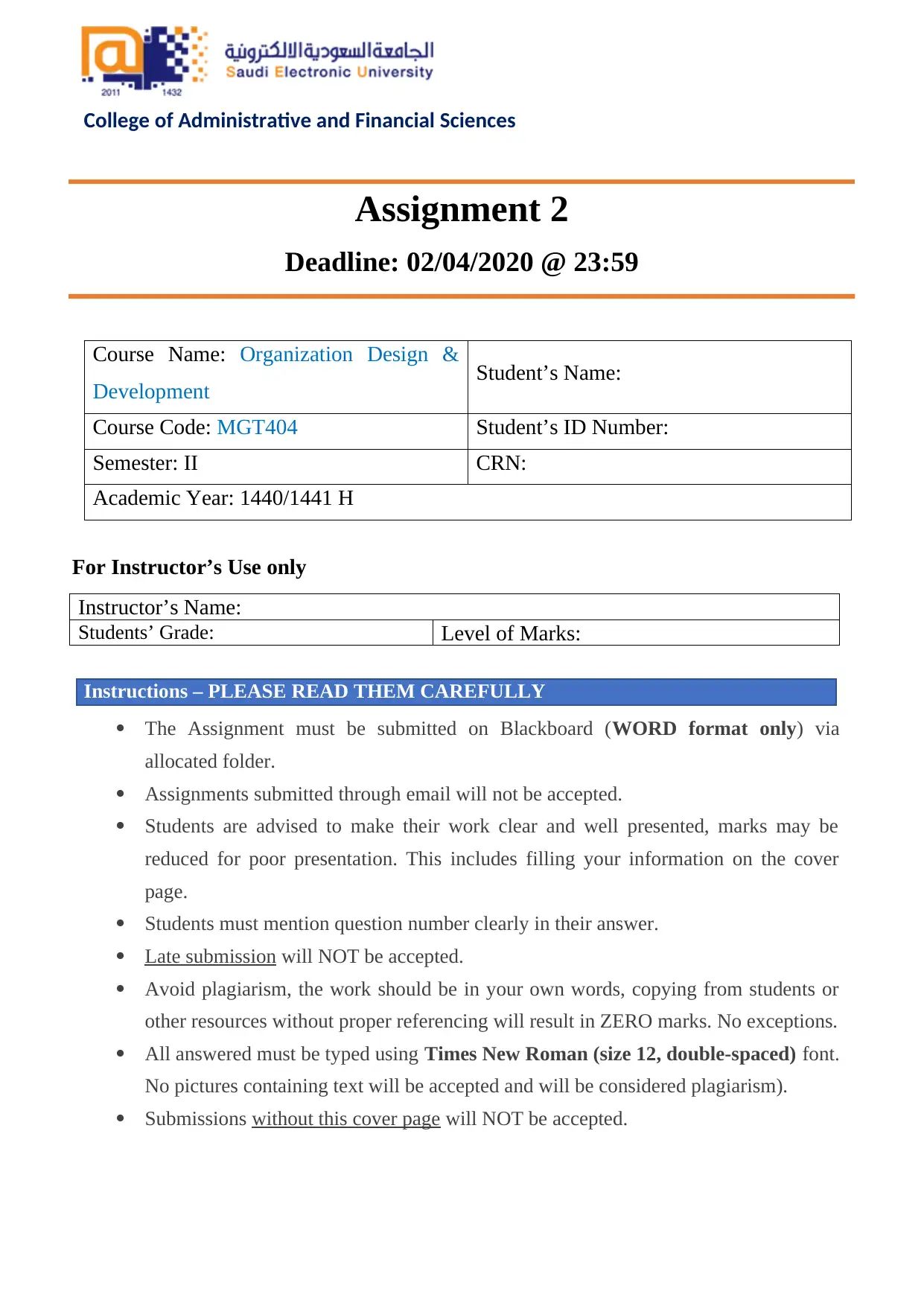
College of Administrative and Financial Sciences
Assignment 2
Deadline: 02/04/2020 @ 23:59
Course Name: Organization Design &
Development Student’s Name:
Course Code: MGT404 Student’s ID Number:
Semester: II CRN:
Academic Year: 1440/1441 H
For Instructor’s Use only
Instructor’s Name:
Students’ Grade: Level of Marks:
Instructions – PLEASE READ THEM CAREFULLY
The Assignment must be submitted on Blackboard (WORD format only) via
allocated folder.
Assignments submitted through email will not be accepted.
Students are advised to make their work clear and well presented, marks may be
reduced for poor presentation. This includes filling your information on the cover
page.
Students must mention question number clearly in their answer.
Late submission will NOT be accepted.
Avoid plagiarism, the work should be in your own words, copying from students or
other resources without proper referencing will result in ZERO marks. No exceptions.
All answered must be typed using Times New Roman (size 12, double-spaced) font.
No pictures containing text will be accepted and will be considered plagiarism).
Submissions without this cover page will NOT be accepted.
Assignment 2
Deadline: 02/04/2020 @ 23:59
Course Name: Organization Design &
Development Student’s Name:
Course Code: MGT404 Student’s ID Number:
Semester: II CRN:
Academic Year: 1440/1441 H
For Instructor’s Use only
Instructor’s Name:
Students’ Grade: Level of Marks:
Instructions – PLEASE READ THEM CAREFULLY
The Assignment must be submitted on Blackboard (WORD format only) via
allocated folder.
Assignments submitted through email will not be accepted.
Students are advised to make their work clear and well presented, marks may be
reduced for poor presentation. This includes filling your information on the cover
page.
Students must mention question number clearly in their answer.
Late submission will NOT be accepted.
Avoid plagiarism, the work should be in your own words, copying from students or
other resources without proper referencing will result in ZERO marks. No exceptions.
All answered must be typed using Times New Roman (size 12, double-spaced) font.
No pictures containing text will be accepted and will be considered plagiarism).
Submissions without this cover page will NOT be accepted.
Paraphrase This Document
Need a fresh take? Get an instant paraphrase of this document with our AI Paraphraser
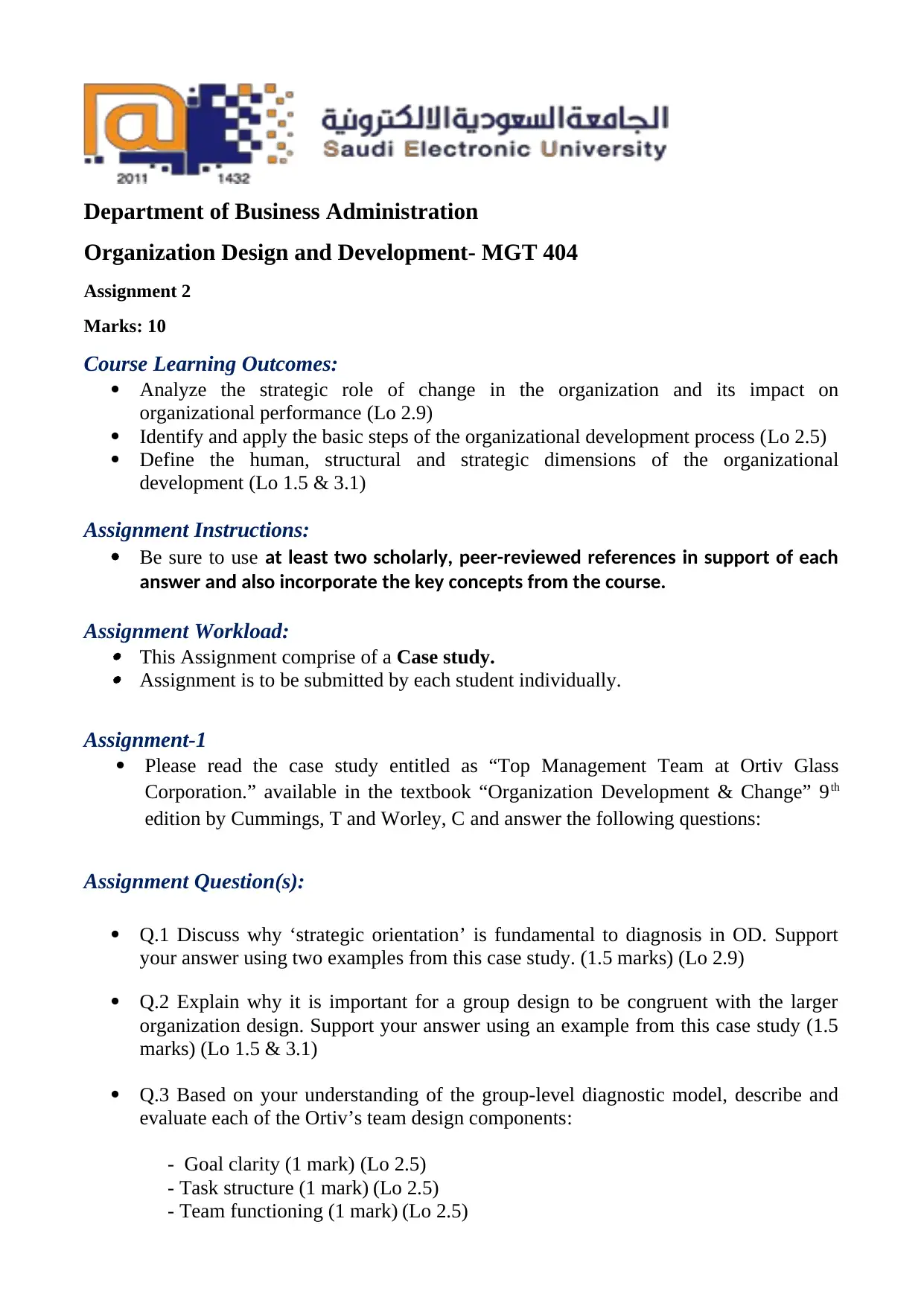
Department of Business Administration
Organization Design and Development- MGT 404
Assignment 2
Marks: 10
Course Learning Outcomes:
Analyze the strategic role of change in the organization and its impact on
organizational performance (Lo 2.9)
Identify and apply the basic steps of the organizational development process (Lo 2.5)
Define the human, structural and strategic dimensions of the organizational
development (Lo 1.5 & 3.1)
Assignment Instructions:
Be sure to use at least two scholarly, peer-reviewed references in support of each
answer and also incorporate the key concepts from the course.
Assignment Workload: This Assignment comprise of a Case study. Assignment is to be submitted by each student individually.
Assignment-1
Please read the case study entitled as “Top Management Team at Ortiv Glass
Corporation.” available in the textbook “Organization Development & Change” 9th
edition by Cummings, T and Worley, C and answer the following questions:
Assignment Question(s):
Q.1 Discuss why ‘strategic orientation’ is fundamental to diagnosis in OD. Support
your answer using two examples from this case study. (1.5 marks) (Lo 2.9)
Q.2 Explain why it is important for a group design to be congruent with the larger
organization design. Support your answer using an example from this case study (1.5
marks) (Lo 1.5 & 3.1)
Q.3 Based on your understanding of the group-level diagnostic model, describe and
evaluate each of the Ortiv’s team design components:
- Goal clarity (1 mark) (Lo 2.5)
- Task structure (1 mark) (Lo 2.5)
- Team functioning (1 mark) (Lo 2.5)
Organization Design and Development- MGT 404
Assignment 2
Marks: 10
Course Learning Outcomes:
Analyze the strategic role of change in the organization and its impact on
organizational performance (Lo 2.9)
Identify and apply the basic steps of the organizational development process (Lo 2.5)
Define the human, structural and strategic dimensions of the organizational
development (Lo 1.5 & 3.1)
Assignment Instructions:
Be sure to use at least two scholarly, peer-reviewed references in support of each
answer and also incorporate the key concepts from the course.
Assignment Workload: This Assignment comprise of a Case study. Assignment is to be submitted by each student individually.
Assignment-1
Please read the case study entitled as “Top Management Team at Ortiv Glass
Corporation.” available in the textbook “Organization Development & Change” 9th
edition by Cummings, T and Worley, C and answer the following questions:
Assignment Question(s):
Q.1 Discuss why ‘strategic orientation’ is fundamental to diagnosis in OD. Support
your answer using two examples from this case study. (1.5 marks) (Lo 2.9)
Q.2 Explain why it is important for a group design to be congruent with the larger
organization design. Support your answer using an example from this case study (1.5
marks) (Lo 1.5 & 3.1)
Q.3 Based on your understanding of the group-level diagnostic model, describe and
evaluate each of the Ortiv’s team design components:
- Goal clarity (1 mark) (Lo 2.5)
- Task structure (1 mark) (Lo 2.5)
- Team functioning (1 mark) (Lo 2.5)
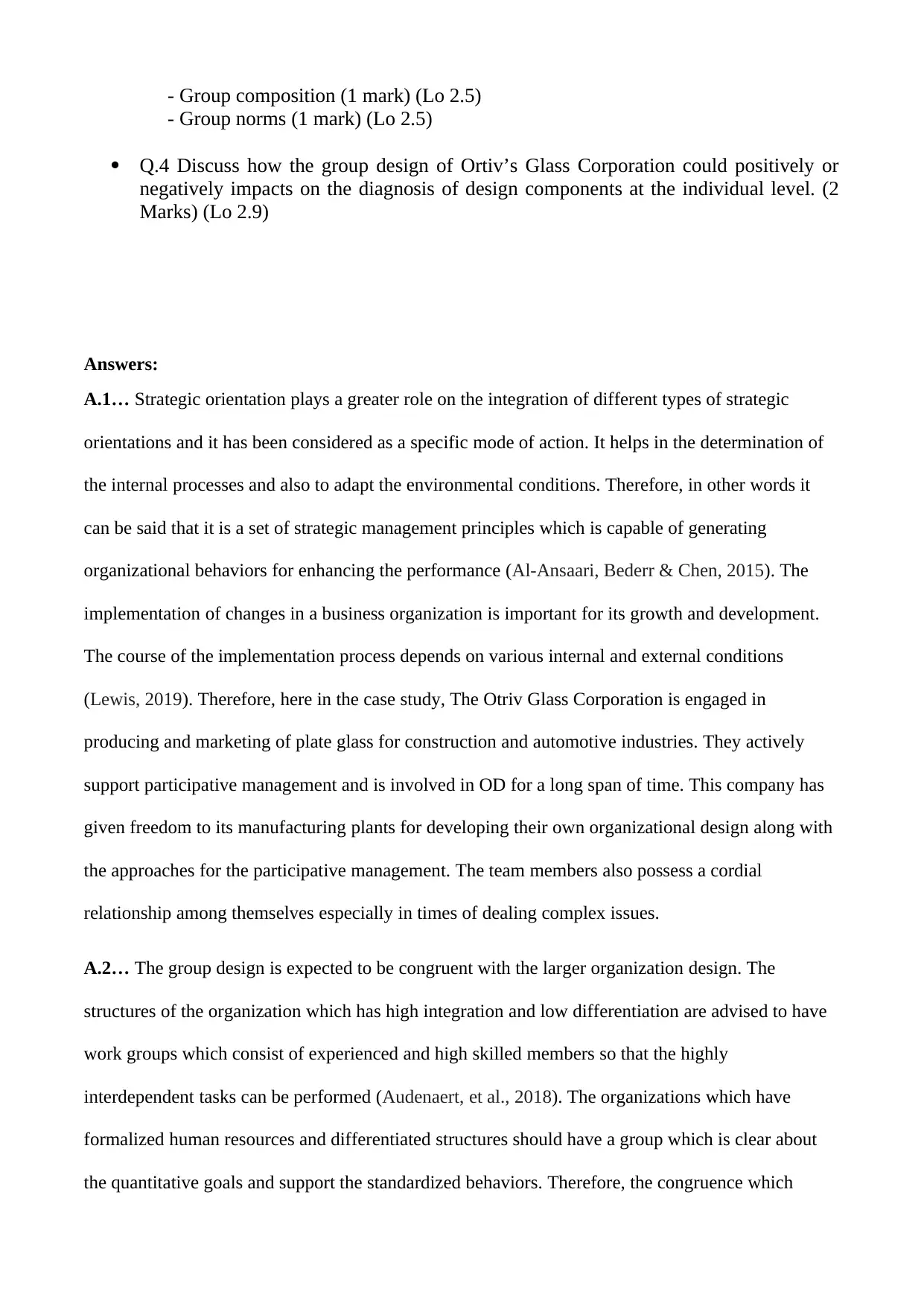
- Group composition (1 mark) (Lo 2.5)
- Group norms (1 mark) (Lo 2.5)
Q.4 Discuss how the group design of Ortiv’s Glass Corporation could positively or
negatively impacts on the diagnosis of design components at the individual level. (2
Marks) (Lo 2.9)
Answers:
A.1… Strategic orientation plays a greater role on the integration of different types of strategic
orientations and it has been considered as a specific mode of action. It helps in the determination of
the internal processes and also to adapt the environmental conditions. Therefore, in other words it
can be said that it is a set of strategic management principles which is capable of generating
organizational behaviors for enhancing the performance (Al-Ansaari, Bederr & Chen, 2015). The
implementation of changes in a business organization is important for its growth and development.
The course of the implementation process depends on various internal and external conditions
(Lewis, 2019). Therefore, here in the case study, The Otriv Glass Corporation is engaged in
producing and marketing of plate glass for construction and automotive industries. They actively
support participative management and is involved in OD for a long span of time. This company has
given freedom to its manufacturing plants for developing their own organizational design along with
the approaches for the participative management. The team members also possess a cordial
relationship among themselves especially in times of dealing complex issues.
A.2… The group design is expected to be congruent with the larger organization design. The
structures of the organization which has high integration and low differentiation are advised to have
work groups which consist of experienced and high skilled members so that the highly
interdependent tasks can be performed (Audenaert, et al., 2018). The organizations which have
formalized human resources and differentiated structures should have a group which is clear about
the quantitative goals and support the standardized behaviors. Therefore, the congruence which
- Group norms (1 mark) (Lo 2.5)
Q.4 Discuss how the group design of Ortiv’s Glass Corporation could positively or
negatively impacts on the diagnosis of design components at the individual level. (2
Marks) (Lo 2.9)
Answers:
A.1… Strategic orientation plays a greater role on the integration of different types of strategic
orientations and it has been considered as a specific mode of action. It helps in the determination of
the internal processes and also to adapt the environmental conditions. Therefore, in other words it
can be said that it is a set of strategic management principles which is capable of generating
organizational behaviors for enhancing the performance (Al-Ansaari, Bederr & Chen, 2015). The
implementation of changes in a business organization is important for its growth and development.
The course of the implementation process depends on various internal and external conditions
(Lewis, 2019). Therefore, here in the case study, The Otriv Glass Corporation is engaged in
producing and marketing of plate glass for construction and automotive industries. They actively
support participative management and is involved in OD for a long span of time. This company has
given freedom to its manufacturing plants for developing their own organizational design along with
the approaches for the participative management. The team members also possess a cordial
relationship among themselves especially in times of dealing complex issues.
A.2… The group design is expected to be congruent with the larger organization design. The
structures of the organization which has high integration and low differentiation are advised to have
work groups which consist of experienced and high skilled members so that the highly
interdependent tasks can be performed (Audenaert, et al., 2018). The organizations which have
formalized human resources and differentiated structures should have a group which is clear about
the quantitative goals and support the standardized behaviors. Therefore, the congruence which
⊘ This is a preview!⊘
Do you want full access?
Subscribe today to unlock all pages.

Trusted by 1+ million students worldwide
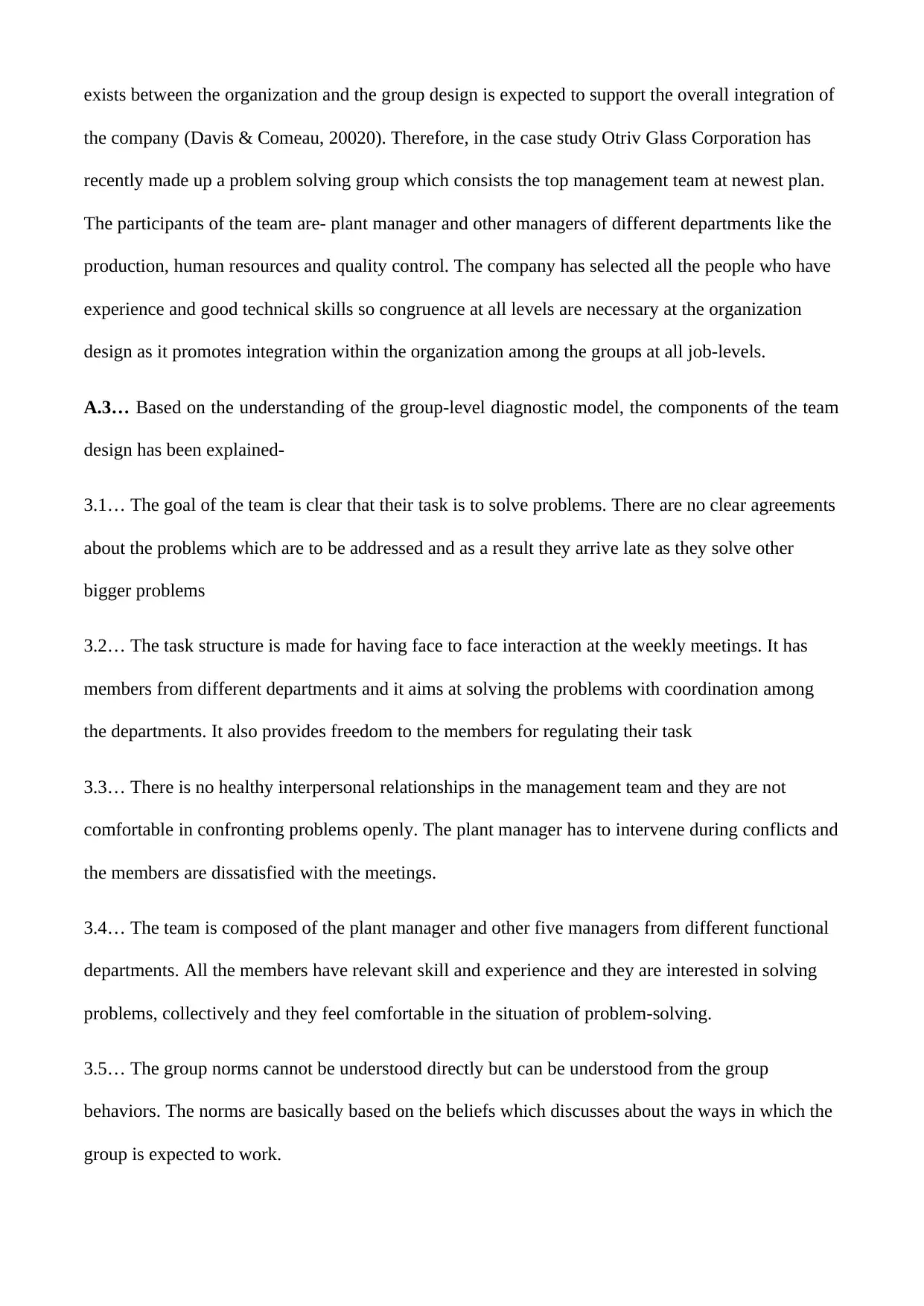
exists between the organization and the group design is expected to support the overall integration of
the company (Davis & Comeau, 20020). Therefore, in the case study Otriv Glass Corporation has
recently made up a problem solving group which consists the top management team at newest plan.
The participants of the team are- plant manager and other managers of different departments like the
production, human resources and quality control. The company has selected all the people who have
experience and good technical skills so congruence at all levels are necessary at the organization
design as it promotes integration within the organization among the groups at all job-levels.
A.3… Based on the understanding of the group-level diagnostic model, the components of the team
design has been explained-
3.1… The goal of the team is clear that their task is to solve problems. There are no clear agreements
about the problems which are to be addressed and as a result they arrive late as they solve other
bigger problems
3.2… The task structure is made for having face to face interaction at the weekly meetings. It has
members from different departments and it aims at solving the problems with coordination among
the departments. It also provides freedom to the members for regulating their task
3.3… There is no healthy interpersonal relationships in the management team and they are not
comfortable in confronting problems openly. The plant manager has to intervene during conflicts and
the members are dissatisfied with the meetings.
3.4… The team is composed of the plant manager and other five managers from different functional
departments. All the members have relevant skill and experience and they are interested in solving
problems, collectively and they feel comfortable in the situation of problem-solving.
3.5… The group norms cannot be understood directly but can be understood from the group
behaviors. The norms are basically based on the beliefs which discusses about the ways in which the
group is expected to work.
the company (Davis & Comeau, 20020). Therefore, in the case study Otriv Glass Corporation has
recently made up a problem solving group which consists the top management team at newest plan.
The participants of the team are- plant manager and other managers of different departments like the
production, human resources and quality control. The company has selected all the people who have
experience and good technical skills so congruence at all levels are necessary at the organization
design as it promotes integration within the organization among the groups at all job-levels.
A.3… Based on the understanding of the group-level diagnostic model, the components of the team
design has been explained-
3.1… The goal of the team is clear that their task is to solve problems. There are no clear agreements
about the problems which are to be addressed and as a result they arrive late as they solve other
bigger problems
3.2… The task structure is made for having face to face interaction at the weekly meetings. It has
members from different departments and it aims at solving the problems with coordination among
the departments. It also provides freedom to the members for regulating their task
3.3… There is no healthy interpersonal relationships in the management team and they are not
comfortable in confronting problems openly. The plant manager has to intervene during conflicts and
the members are dissatisfied with the meetings.
3.4… The team is composed of the plant manager and other five managers from different functional
departments. All the members have relevant skill and experience and they are interested in solving
problems, collectively and they feel comfortable in the situation of problem-solving.
3.5… The group norms cannot be understood directly but can be understood from the group
behaviors. The norms are basically based on the beliefs which discusses about the ways in which the
group is expected to work.
Paraphrase This Document
Need a fresh take? Get an instant paraphrase of this document with our AI Paraphraser
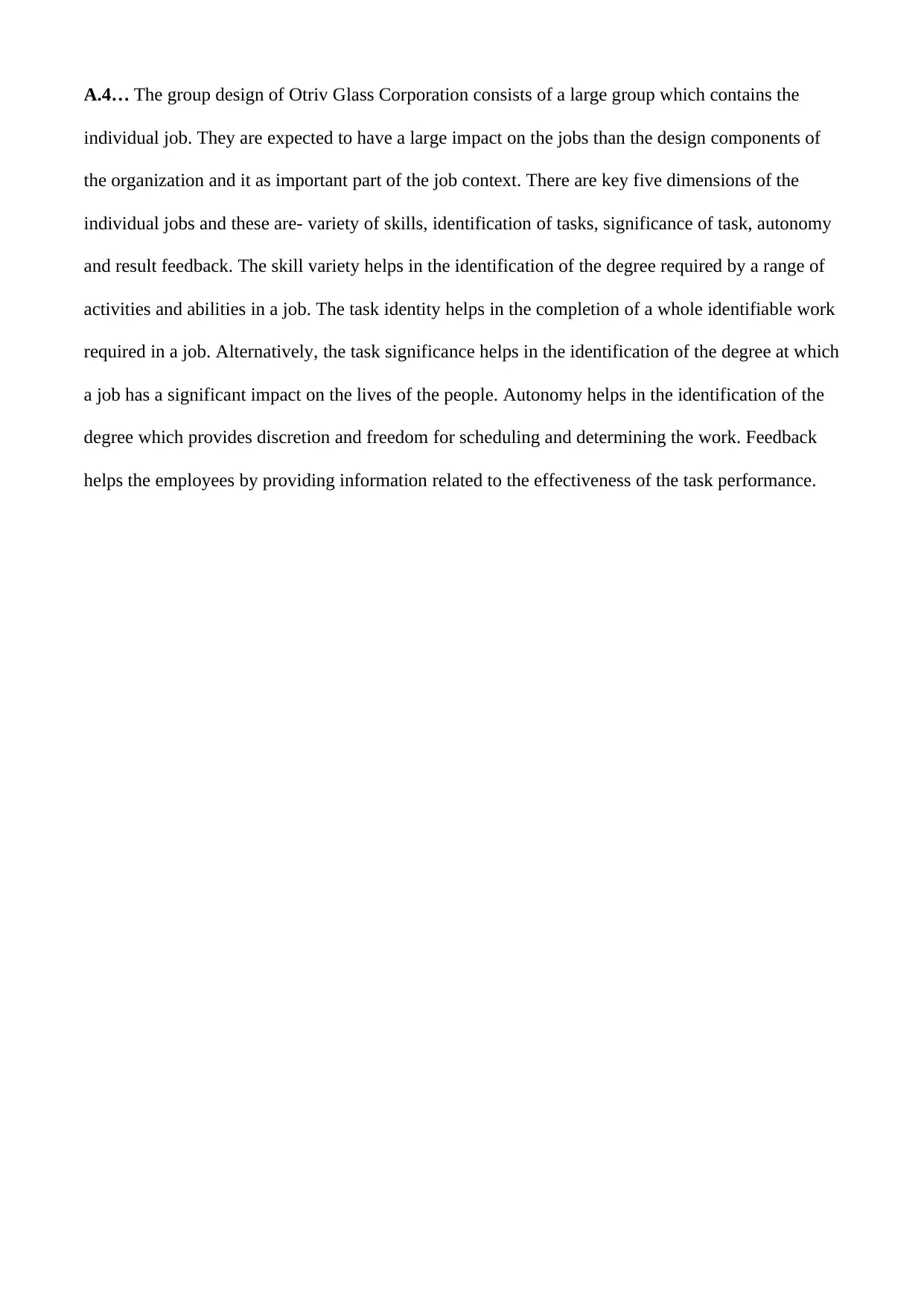
A.4… The group design of Otriv Glass Corporation consists of a large group which contains the
individual job. They are expected to have a large impact on the jobs than the design components of
the organization and it as important part of the job context. There are key five dimensions of the
individual jobs and these are- variety of skills, identification of tasks, significance of task, autonomy
and result feedback. The skill variety helps in the identification of the degree required by a range of
activities and abilities in a job. The task identity helps in the completion of a whole identifiable work
required in a job. Alternatively, the task significance helps in the identification of the degree at which
a job has a significant impact on the lives of the people. Autonomy helps in the identification of the
degree which provides discretion and freedom for scheduling and determining the work. Feedback
helps the employees by providing information related to the effectiveness of the task performance.
individual job. They are expected to have a large impact on the jobs than the design components of
the organization and it as important part of the job context. There are key five dimensions of the
individual jobs and these are- variety of skills, identification of tasks, significance of task, autonomy
and result feedback. The skill variety helps in the identification of the degree required by a range of
activities and abilities in a job. The task identity helps in the completion of a whole identifiable work
required in a job. Alternatively, the task significance helps in the identification of the degree at which
a job has a significant impact on the lives of the people. Autonomy helps in the identification of the
degree which provides discretion and freedom for scheduling and determining the work. Feedback
helps the employees by providing information related to the effectiveness of the task performance.
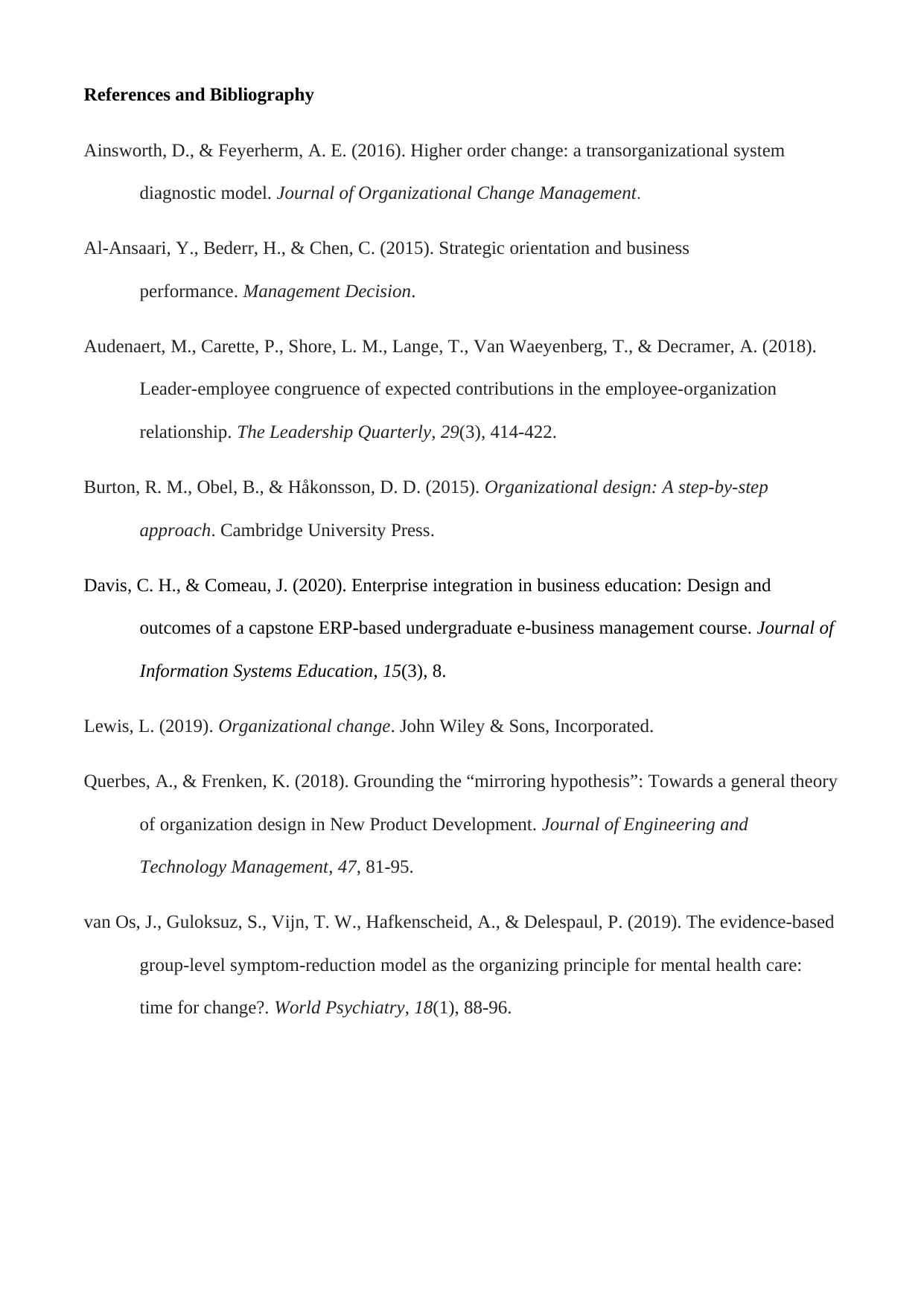
References and Bibliography
Ainsworth, D., & Feyerherm, A. E. (2016). Higher order change: a transorganizational system
diagnostic model. Journal of Organizational Change Management.
Al-Ansaari, Y., Bederr, H., & Chen, C. (2015). Strategic orientation and business
performance. Management Decision.
Audenaert, M., Carette, P., Shore, L. M., Lange, T., Van Waeyenberg, T., & Decramer, A. (2018).
Leader-employee congruence of expected contributions in the employee-organization
relationship. The Leadership Quarterly, 29(3), 414-422.
Burton, R. M., Obel, B., & Håkonsson, D. D. (2015). Organizational design: A step-by-step
approach. Cambridge University Press.
Davis, C. H., & Comeau, J. (2020). Enterprise integration in business education: Design and
outcomes of a capstone ERP-based undergraduate e-business management course. Journal of
Information Systems Education, 15(3), 8.
Lewis, L. (2019). Organizational change. John Wiley & Sons, Incorporated.
Querbes, A., & Frenken, K. (2018). Grounding the “mirroring hypothesis”: Towards a general theory
of organization design in New Product Development. Journal of Engineering and
Technology Management, 47, 81-95.
van Os, J., Guloksuz, S., Vijn, T. W., Hafkenscheid, A., & Delespaul, P. (2019). The evidence‐based
group‐level symptom‐reduction model as the organizing principle for mental health care:
time for change?. World Psychiatry, 18(1), 88-96.
Ainsworth, D., & Feyerherm, A. E. (2016). Higher order change: a transorganizational system
diagnostic model. Journal of Organizational Change Management.
Al-Ansaari, Y., Bederr, H., & Chen, C. (2015). Strategic orientation and business
performance. Management Decision.
Audenaert, M., Carette, P., Shore, L. M., Lange, T., Van Waeyenberg, T., & Decramer, A. (2018).
Leader-employee congruence of expected contributions in the employee-organization
relationship. The Leadership Quarterly, 29(3), 414-422.
Burton, R. M., Obel, B., & Håkonsson, D. D. (2015). Organizational design: A step-by-step
approach. Cambridge University Press.
Davis, C. H., & Comeau, J. (2020). Enterprise integration in business education: Design and
outcomes of a capstone ERP-based undergraduate e-business management course. Journal of
Information Systems Education, 15(3), 8.
Lewis, L. (2019). Organizational change. John Wiley & Sons, Incorporated.
Querbes, A., & Frenken, K. (2018). Grounding the “mirroring hypothesis”: Towards a general theory
of organization design in New Product Development. Journal of Engineering and
Technology Management, 47, 81-95.
van Os, J., Guloksuz, S., Vijn, T. W., Hafkenscheid, A., & Delespaul, P. (2019). The evidence‐based
group‐level symptom‐reduction model as the organizing principle for mental health care:
time for change?. World Psychiatry, 18(1), 88-96.
⊘ This is a preview!⊘
Do you want full access?
Subscribe today to unlock all pages.

Trusted by 1+ million students worldwide

1 out of 7
Related Documents
Your All-in-One AI-Powered Toolkit for Academic Success.
+13062052269
info@desklib.com
Available 24*7 on WhatsApp / Email
![[object Object]](/_next/static/media/star-bottom.7253800d.svg)
Unlock your academic potential
Copyright © 2020–2025 A2Z Services. All Rights Reserved. Developed and managed by ZUCOL.





